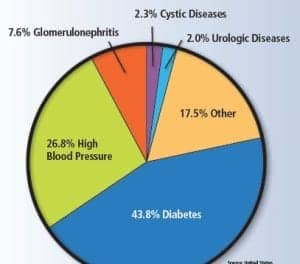Biodesix, Boulder, Colo, recently presented preliminary data evaluating a blood-based programmed cell death ligand 1 (PD-L1) assay to identify patients who may benefit from cancer immunotherapies.1
The study was conducted in collaboration with Michael Pritchett, DO, MPH, from FirstHealth Moore Regional Hospital, Pinehurst Medical Clinic, and Jiaxin Niu, MD, PhD, from Banner MD Anderson Cancer Center.
“Measurement of PD-L1 is challenging not only when tissue is lacking, but due to the inherent complexity of immunohistochemistry,” says Pritchett. “The testing approach demonstrated in this study shows promise as a method of assessing PD-L1 in plasma. A more objective measure of PD-L1 status could offer a path to better patient care decisions in the treatment of non-small cell lung cancer.”
PD-L1 has been detected in up to 50% of all human cancers, and has become a major focus of biomarker and therapeutic research.2 Patients with cancers that express the PD-L1 protein are more likely to respond to certain immunooncology therapeutics, and several PD-L1-related immunooncology therapies have received FDA approval.
The study refers to an assay under development at Biodesix that uses multiplexed droplet digital polymerase chain reaction detection of circulating mRNA. PD-L1 levels were also measured using a quantitative polymerase chain reaction method. The study results demonstrated a strong correlation between the two technologies.
The investigational methodology incorporates CK19 expression to identify PD-L1 derived from activated immune cells and tumor cells. In the study, preliminary thresholds were identified for the developmental PD-L1 assay based on 1% and 50% cut-offs with the PharmDx 22c3 immunohistochemistry assay. Although concordance with a 50% positive immunohistochemistry cut-off was not significant, when a variable threshold was used based on a logistic regression score for the blood assay along with the 1% cut-off, concordance of up to 80% was observed between the two assays.
“Eighty percent correlation between blood-based and tissue-based PD-L1 results is impressive, and clinically meaningful,” says Niu. “If confirmed prospectively with simultaneously collected samples, it would be very convincing and have significant clinical implications.”
REFERENCES
- Pritchett MA, Niu J, Jackson L, Mellert H, Pestano GA. Concordance of IHC and a new blood-based expression assay for the detection of PD-L1 in patients diagnosed with non-small cell lung cancer [abstract, online]. Poster presented at the AACR-NCI-EORTC International Conference on Molecular Targets and Cancer Therapeutics: Discovery, Biology, and Clinical Applications, Philadelphia, October 26–30, 2017. Available at: abstractsonline.com/pp8/#!/4557/presentation/140. Accessed December 8, 2017.
- Chen DS, Irving BA, Hodi FS. Molecular pathways: next-generation immunotherapy—inhibiting programmed death-ligand 1 and programmed death-1. Clin Cancer Res. 2012;18(24):6580–6587; doi: 10.1158/1078-0432.ccr-12-1362.







